R. Thukral
Padé Research Centre, 39 Deanswood Hill, Leeds, West Yorkshire, LS17 5JS, England
Correspondence to: R. Thukral, Padé Research Centre, 39 Deanswood Hill, Leeds, West Yorkshire, LS17 5JS, England.
| Email: |  |
Copyright © 2014 Scientific & Academic Publishing. All Rights Reserved.
Abstract
In this paper, four new ninth order iterative methods for solving nonlinear equations are constructed. It is proved that these methods have the convergence order of nine requiring six function evaluations per iteration. Numerical comparisons are included to demonstrate exceptional convergence speed of the proposed methods.
Keywords:
Modified newton method, Root-finding, Nonlinear equations, Multiple roots, Order of convergence, Efficiency index
Cite this paper: R. Thukral, New Ninth Order Iterative Methods for Finding Multiple Roots of Nonlinear Equations, American Journal of Computational and Applied Mathematics , Vol. 4 No. 3, 2014, pp. 77-82. doi: 10.5923/j.ajcam.20140403.02.
1. Introduction
Solving nonlinear equations is one of the most important problems in numerical analysis. In this paper, we consider iterative methods to find a multiple root  of multiplicity m, i.e.,
of multiplicity m, i.e., 
 and
and  of a nonlinear equation
of a nonlinear equation  | (1) |
where  is a scalar function on an open interval I and it is sufficiently smooth in the neighbourhood of
is a scalar function on an open interval I and it is sufficiently smooth in the neighbourhood of  . In recent years, some modifications of the Newton method for multiple roots have been proposed and analysed [1-21]. However, there are not many methods known to handle the case of multiple roots, hence we present higher order methods for finding multiple zeros of a nonlinear equation, based on six evaluations of the function per iteration. In addition, the new ninth order methods have a better efficiency index than the eighth order methods presented in this paper.We begin with the well-known modified Newton’s method for finding multiple roots, which is given by
. In recent years, some modifications of the Newton method for multiple roots have been proposed and analysed [1-21]. However, there are not many methods known to handle the case of multiple roots, hence we present higher order methods for finding multiple zeros of a nonlinear equation, based on six evaluations of the function per iteration. In addition, the new ninth order methods have a better efficiency index than the eighth order methods presented in this paper.We begin with the well-known modified Newton’s method for finding multiple roots, which is given by | (2) |
which converges quadratically [6, 19]. Furthermore, in [21] Wu et al. introduced a fourth order Newton method for computing multiple roots, which is given as | (3) |
 | (4) |
 is the initial guess, provided that the denominators of (4) are not equal to zero. Simply repeating the scheme (2), the fourth order convergence method is formed. For the purpose of this paper, we repeat once more to obtain an eighth-order method. Hence we have constructed eighth-order methods for finding multiple roots of nonlinear equations. In order to construct the new eighth order method for finding multiple roots we use the concept applied in [21], therefore the new eighth order method is expressed as
is the initial guess, provided that the denominators of (4) are not equal to zero. Simply repeating the scheme (2), the fourth order convergence method is formed. For the purpose of this paper, we repeat once more to obtain an eighth-order method. Hence we have constructed eighth-order methods for finding multiple roots of nonlinear equations. In order to construct the new eighth order method for finding multiple roots we use the concept applied in [21], therefore the new eighth order method is expressed as | (5) |
 | (6) |
 | (7) |
 is the initial guess, provided that the denominators of (5) - (7) are not equal to zero.Theorem 1Let
is the initial guess, provided that the denominators of (5) - (7) are not equal to zero.Theorem 1Let  be a multiple root of multiplicity m of a sufficiently differentiable function
be a multiple root of multiplicity m of a sufficiently differentiable function  for an open interval I. If
for an open interval I. If  is sufficiently close to
is sufficiently close to  , suppose that the order of convergence of the iterative method
, suppose that the order of convergence of the iterative method  is k, then the convergence rate of
is k, then the convergence rate of  is
is  .ProofSince the convergence rate of
.ProofSince the convergence rate of  is k, and the error equation of
is k, and the error equation of  can be written as
can be written as  | (8) |
where | (9) |
Substituting (9) into (8), the error equation of  is
is  | (10) |
Repeating the process once more, the error equation of  is
is  | (11) |
where  are constants. The error equation (11) establishes the
are constants. The error equation (11) establishes the  order convergence of the new method. Theorem 2Assume that the function
order convergence of the new method. Theorem 2Assume that the function  for an open interval I has a simple root
for an open interval I has a simple root  If
If  is sufficiently smooth in the neighbourhood of the root
is sufficiently smooth in the neighbourhood of the root  then the method defined by (7) is of order eight.ProofIt is well established that the order of convergence of the modified Newton method (5) is 2, thus
then the method defined by (7) is of order eight.ProofIt is well established that the order of convergence of the modified Newton method (5) is 2, thus . Therefore, from theorem 1, the iterative method defined by (7) has eighth order convergence. The prime motive of this study is to develop a new class of multi-step methods for finding multiple roots of nonlinear equations. In order to construct the new ninth order method for finding multiple roots we use the well-established third order methods given [2, 8, 11, 19]. The ninth and eighth order methods presented in this paper are based on six evaluations of the function per iteration. Consequently, the new ninth order methods have a better efficiency index than the eighth order method.The paper is organized as follows. In section 2 we state some of the definitions applicable to the methods proposed in this paper. In section 3, four new iterative methods of ninth order are constructed simply by transforming the well-established third order methods furthermore convergence analysis is provided to establish the ninth order convergence. Finally, in section 4, several numerical examples are given to demonstrate the performance of the new ninth order methods.
. Therefore, from theorem 1, the iterative method defined by (7) has eighth order convergence. The prime motive of this study is to develop a new class of multi-step methods for finding multiple roots of nonlinear equations. In order to construct the new ninth order method for finding multiple roots we use the well-established third order methods given [2, 8, 11, 19]. The ninth and eighth order methods presented in this paper are based on six evaluations of the function per iteration. Consequently, the new ninth order methods have a better efficiency index than the eighth order method.The paper is organized as follows. In section 2 we state some of the definitions applicable to the methods proposed in this paper. In section 3, four new iterative methods of ninth order are constructed simply by transforming the well-established third order methods furthermore convergence analysis is provided to establish the ninth order convergence. Finally, in section 4, several numerical examples are given to demonstrate the performance of the new ninth order methods.
2. Basic Definitions
In order to establish the order of convergence of the new ninth order methods, we state some of the definitions:Definition 1 Let  be a real-valued function with a simple root
be a real-valued function with a simple root  and let
and let  be a sequence of real numbers that converge towards
be a sequence of real numbers that converge towards  . The order of convergence p is given by
. The order of convergence p is given by | (12) |
where  and
and  is the asymptotic error constant [6, 19]. Definition 2 Let
is the asymptotic error constant [6, 19]. Definition 2 Let  be the error in the kth iteration, then the relation
be the error in the kth iteration, then the relation | (13) |
is the error equation. If the error equation exists, then p is the order of convergence of the iterative method [6, 19].Definition 3 Let r be the number of function evaluations of the new method. The efficiency of the new method is measured by the concept of efficiency index and defined as | (14) |
where p is the order of the method [6, 19].Definition 4 Suppose that  and
and  are three successive iterations closer to the root
are three successive iterations closer to the root  of (1), then the computational order of convergence [20] may be approximated by
of (1), then the computational order of convergence [20] may be approximated by  | (15) |
3. Development of the Methods and Convergence Analysis
In this section we define new ninth order methods for finding multiple roots of a nonlinear equation. The new ninth order methods are based on well-known third order methods [2, 8, 11, 19], namely the Osada third order method, the Halley third order method, the Euler-Chebyshev third order method, the Chun-Neta third order method. We use these methods to construct the ninth order methods.
3.1. The Osada Ninth Order Method
The first of the new ninth order methods is based on the Osada third order method [11]. The new ninth order iterative method is given as, 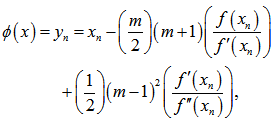 | (16) |
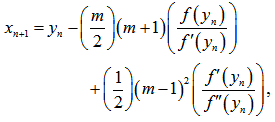 | (17) |
 is the initial guess, provided that the denominators of (17) are not equal to zero.
is the initial guess, provided that the denominators of (17) are not equal to zero.
3.2. The Halley Ninth Order Method
The second of the new ninth order methods is based on the Halley third order method [8]. The new ninth order iterative method is given as,  | (18) |
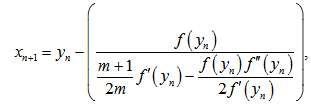 | (19) |
 is the initial guess, provided that the denominators of (19) are not equal to zero.
is the initial guess, provided that the denominators of (19) are not equal to zero.
3.3. The Euler-Chebyshev Ninth Order Method
The third of the new ninth order methods is based on the Euler-Chebyshev third order method [19]. The new ninth order iterative method is given as, 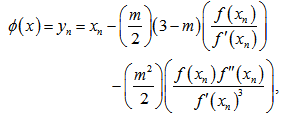 | (20) |
 | (21) |
 is the initial guess, provided that the denominators of (21) are not equal to zero.
is the initial guess, provided that the denominators of (21) are not equal to zero.
3.4. The Chun-Neta Ninth Order Method
The fourth of the new ninth order methods is based on the Chun-Neta third order method [2]. The new ninth order iterative method is given as,  | (22) |
 | (23) |
 is the initial guess, provided that the denominators of (23) are not equal to zero. The above formula is a ninth order convergence method and is efficient in obtaining a multiple root of a nonlinear equation. In numerical mathematics it is essential to know the behaviour of an approximate method. Hence, we prove the order of convergence of the new ninth order methods. The following theorem applies to the ninth order methods formed in this paper.Theorem 3Assume that the function
is the initial guess, provided that the denominators of (23) are not equal to zero. The above formula is a ninth order convergence method and is efficient in obtaining a multiple root of a nonlinear equation. In numerical mathematics it is essential to know the behaviour of an approximate method. Hence, we prove the order of convergence of the new ninth order methods. The following theorem applies to the ninth order methods formed in this paper.Theorem 3Assume that the function  for an open interval I has a simple root
for an open interval I has a simple root  If
If  is sufficiently smooth in the neighbourhood of the root
is sufficiently smooth in the neighbourhood of the root  then the methods defined by (17), (19), (21), and (23) is of order nine.ProofIt is well established that the order of convergence of the methods (16), (18), (20) and (22) is 3, thus
then the methods defined by (17), (19), (21), and (23) is of order nine.ProofIt is well established that the order of convergence of the methods (16), (18), (20) and (22) is 3, thus  . Therefore, from theorem 1, the iterative methods defined by (17), (19), (21), and (23) have ninth order convergence.
. Therefore, from theorem 1, the iterative methods defined by (17), (19), (21), and (23) have ninth order convergence.
4. Application of the New Iterative Methods
The present higher order methods given by (7), (17), (19), (21), and (23) are employed to solve nonlinear equations with multiple roots. To demonstrate the performance of the new higher order methods, we use ten particular nonlinear equations. We shall determine the consistency and stability of results by examining the convergence of the new iterative methods. The findings are generalised by illustrating the effectiveness of the higher order methods for determining the multiple root of a nonlinear equation. Consequently, we give estimates of the approximate solution produced by the methods considered and list the errors obtained by each of the methods. The numerical computations listed in the tables were performed on an algebraic system called Maple. In fact, the errors displayed are of absolute value and insignificant approximations by the various methods have been omitted in the following tables. Remark 1The new ninth order method requires six function evaluations and has the order of convergence nine. To determine the efficiency index of the new method, we shall use the definition 2. Hence, the efficiency index of the new methods given by (17), (19), (21), and (23) is  whereas the efficiency index of the eighth order methods (7) is given as
whereas the efficiency index of the eighth order methods (7) is given as . We can see that the efficiency index of the new ninth order method is better than the eighth order method. Remark 2The test functions and their exact root
. We can see that the efficiency index of the new ninth order method is better than the eighth order method. Remark 2The test functions and their exact root  are displayed in table 1. The difference between the root
are displayed in table 1. The difference between the root  and the approximation
and the approximation  for test functions with initial guess
for test functions with initial guess  are displayed in tables. In fact,
are displayed in tables. In fact,  is calculated by using the same total number of function evaluations (TNFE) for all methods. Furthermore, the computational orders of convergence (COC) are displayed in tables. From the tables we observe that the COC perfectly coincides with the theoretical result.
is calculated by using the same total number of function evaluations (TNFE) for all methods. Furthermore, the computational orders of convergence (COC) are displayed in tables. From the tables we observe that the COC perfectly coincides with the theoretical result. Table 1. Test functions and their roots
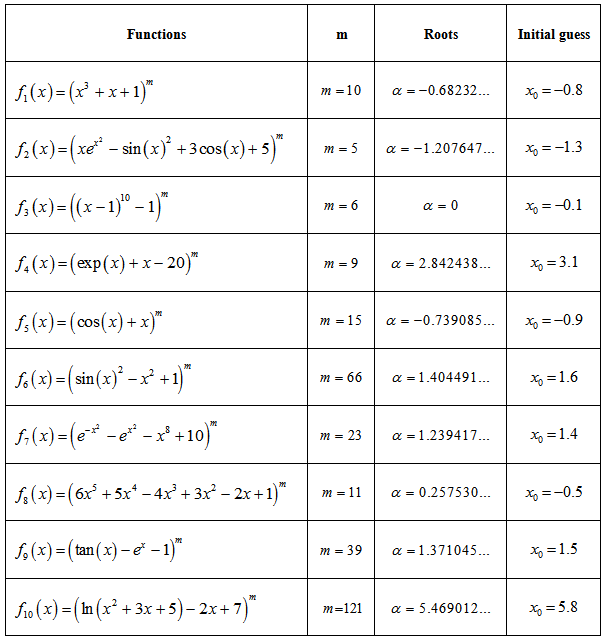 |
| |
|
Table 2. Comparison of iterative methods
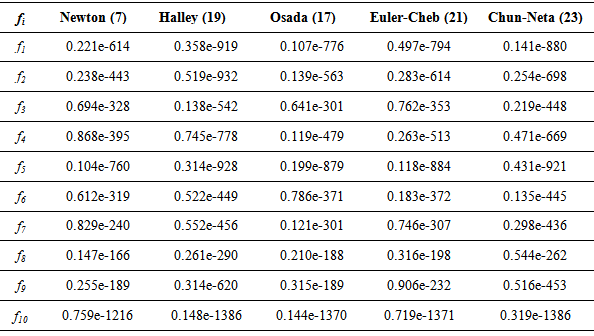 |
| |
|
Table 3. COC of various iterative methods
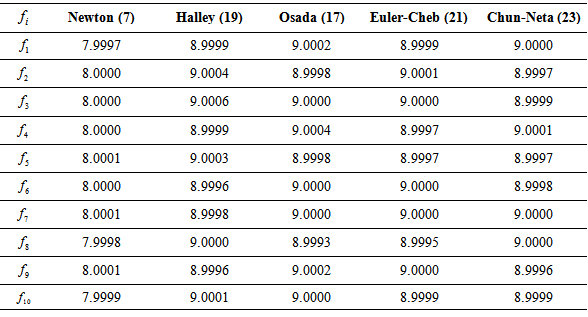 |
| |
|
5. Conclusions
In this paper, we have introduced four new ninth order iterative methods for solving nonlinear equations with multiple roots. Convergence analysis proves that the new methods preserve their order of convergence. Simply repeating the iterative process, we have achieved a ninth order of convergence. The prime motive of presenting these new methods was to establish a higher order of convergence method than the existing methods [1-21]. We have examined the effectiveness of the new methods by showing the accuracy of the multiple roots of several nonlinear equations. After an extensive experimentation, it can be concluded that the convergence of the tested multipoint methods of the ninth order is remarkably fast. The main purpose of demonstrating the new methods for different types of nonlinear equations was purely to illustrate the accuracy of the approximate solution, the stability of the convergence, the consistency of the results and to determine the efficiency of the new iterative method. We have shown numerically, and verified, that the new methods converge to the order nine. Empirically, we have found that the Halley ninth order method is performing better than the other similar methods. Finally, we have constructed new higher order methods, but unfortunately the efficiency of the methods has not increased, hence further investigation is essential.
References
| [1] | Biazar, B. Ghanbari, A new third-order family of nonlinear solvers for multiple roots, Comput. Math. Appl. 59 (2010) 3315-3319. |
| [2] | C. Chun, B. Neta, A third-order modification of Newton’s method for multiple roots, Appl. Math. Comput. 211 (2009) 474-479. |
| [3] | C. Chun, H. Bae, B. Neta, New families of nonlinear third-order solvers for multiple roots, Comput. Math. Appl. 57 (2009) 1574-1582. |
| [4] | C. Dong, A basic theorem of constructing an iterative formula of the higher order of computing multiple roots of an equation, Math. Number. Sinica 11 (1982) 445-450. |
| [5] | C. Dong, A family of multipoint iterative functions for finding multiple roots of equation, Int. J. Comput. Math. 21 (1987) 363-367. |
| [6] | W. Gautschi, Numerical Analysis: an Introduction, Birkhauser, 1997. |
| [7] | B. Ghanbari, B. Rahimi, M. G. Porshokouhi, A new class of third-order methods for multiple zeros, Int. J. Pure Aplll. Sci. Tech. 3 (2011) 65-71. |
| [8] | E. Halley, A new, exact and easy method of finding the roots of equations generally and that without any previous reduction, Phil. Trans. Roy. Soc. London 18 (1694) 136-148. |
| [9] | S. Kumar, V. Kanwar, S. Singh, On some modified families of multipoint iterative methods for multiple roots of nonlinear equations, Appl. Math. Comput. 218 (2012) 7382-7394. |
| [10] | B. Neta, New third order nonlinear solvers for multiple roots, Appl. Math. Comput. 202 (2008) 162-170. |
| [11] | N. Osada, An optimal multiple root-finding method of order three, J. Comput. Appl. Math. 51 (1994) 131-133. |
| [12] | E. Schroder, Uber unendich viele Algorithmen zur Auflosung der Gleichungen, Math. Ann. 2 (1870) 317-365. |
| [13] | J. R. Sharma, R. Sharma, New third and fourth order nonlinear solvers for computing multiple roots, Appl. Math. Comput. 217 (2011) 9756-9764. |
| [14] | R. Thukral, A new third-order iterative method for solving nonlinear equations with multiple roots, J. Math. Comput. 6 (2010) 61-68. |
| [15] | R. Thukral, A new fifth-order iterative method for finding multiple roots of nonlinear equations, Amer. J. Comput. Math. 2 (2012) 260-264. |
| [16] | R. Thukral, Introduction to higher order iterative methods for finding multiple roots of solving nonlinear equations, Int. J. Math. Comput. 2013. |
| [17] | R. Thukral, A new family of multipoint iterative methods for finding multiple roots of nonlinear equations, Amer. J. Comput. Math. 3 (2013) 168-173. |
| [18] | R. Thukral, A family of three-point methods of eighth-order for finding multiple roots of nonlinear equations, J. Mod. Meth. Numer. Math. 4 (2013) 1-9. |
| [19] | J. F. Traub, Iterative Methods for solution of equations, Chelsea publishing company, New York 1977. |
| [20] | S. Weerakoon, T. G. I. Fernando, A variant of Newton’s method with accelerated third-order convergence, Appl. Math. Lett. 13 (2000) 87-93. |
| [21] | Z. Wu, X. Li, A fourth-order modification of Newton’s method for multiple roots, IJRRAS 10 (2) (2012) 166-170. |

 of multiplicity m, i.e.,
of multiplicity m, i.e., 
 and
and  of a nonlinear equation
of a nonlinear equation 
 is a scalar function on an open interval I and it is sufficiently smooth in the neighbourhood of
is a scalar function on an open interval I and it is sufficiently smooth in the neighbourhood of  . In recent years, some modifications of the Newton method for multiple roots have been proposed and analysed [1-21]. However, there are not many methods known to handle the case of multiple roots, hence we present higher order methods for finding multiple zeros of a nonlinear equation, based on six evaluations of the function per iteration. In addition, the new ninth order methods have a better efficiency index than the eighth order methods presented in this paper.We begin with the well-known modified Newton’s method for finding multiple roots, which is given by
. In recent years, some modifications of the Newton method for multiple roots have been proposed and analysed [1-21]. However, there are not many methods known to handle the case of multiple roots, hence we present higher order methods for finding multiple zeros of a nonlinear equation, based on six evaluations of the function per iteration. In addition, the new ninth order methods have a better efficiency index than the eighth order methods presented in this paper.We begin with the well-known modified Newton’s method for finding multiple roots, which is given by


 is the initial guess, provided that the denominators of (4) are not equal to zero. Simply repeating the scheme (2), the fourth order convergence method is formed. For the purpose of this paper, we repeat once more to obtain an eighth-order method. Hence we have constructed eighth-order methods for finding multiple roots of nonlinear equations. In order to construct the new eighth order method for finding multiple roots we use the concept applied in [21], therefore the new eighth order method is expressed as
is the initial guess, provided that the denominators of (4) are not equal to zero. Simply repeating the scheme (2), the fourth order convergence method is formed. For the purpose of this paper, we repeat once more to obtain an eighth-order method. Hence we have constructed eighth-order methods for finding multiple roots of nonlinear equations. In order to construct the new eighth order method for finding multiple roots we use the concept applied in [21], therefore the new eighth order method is expressed as


 is the initial guess, provided that the denominators of (5) - (7) are not equal to zero.Theorem 1Let
is the initial guess, provided that the denominators of (5) - (7) are not equal to zero.Theorem 1Let  be a multiple root of multiplicity m of a sufficiently differentiable function
be a multiple root of multiplicity m of a sufficiently differentiable function  for an open interval I. If
for an open interval I. If  is sufficiently close to
is sufficiently close to  , suppose that the order of convergence of the iterative method
, suppose that the order of convergence of the iterative method  is k, then the convergence rate of
is k, then the convergence rate of  is
is  .ProofSince the convergence rate of
.ProofSince the convergence rate of  is k, and the error equation of
is k, and the error equation of  can be written as
can be written as 

 is
is 
 is
is 
 are constants. The error equation (11) establishes the
are constants. The error equation (11) establishes the  order convergence of the new method. Theorem 2Assume that the function
order convergence of the new method. Theorem 2Assume that the function  for an open interval I has a simple root
for an open interval I has a simple root  If
If  is sufficiently smooth in the neighbourhood of the root
is sufficiently smooth in the neighbourhood of the root  then the method defined by (7) is of order eight.ProofIt is well established that the order of convergence of the modified Newton method (5) is 2, thus
then the method defined by (7) is of order eight.ProofIt is well established that the order of convergence of the modified Newton method (5) is 2, thus . Therefore, from theorem 1, the iterative method defined by (7) has eighth order convergence. The prime motive of this study is to develop a new class of multi-step methods for finding multiple roots of nonlinear equations. In order to construct the new ninth order method for finding multiple roots we use the well-established third order methods given [2, 8, 11, 19]. The ninth and eighth order methods presented in this paper are based on six evaluations of the function per iteration. Consequently, the new ninth order methods have a better efficiency index than the eighth order method.The paper is organized as follows. In section 2 we state some of the definitions applicable to the methods proposed in this paper. In section 3, four new iterative methods of ninth order are constructed simply by transforming the well-established third order methods furthermore convergence analysis is provided to establish the ninth order convergence. Finally, in section 4, several numerical examples are given to demonstrate the performance of the new ninth order methods.
. Therefore, from theorem 1, the iterative method defined by (7) has eighth order convergence. The prime motive of this study is to develop a new class of multi-step methods for finding multiple roots of nonlinear equations. In order to construct the new ninth order method for finding multiple roots we use the well-established third order methods given [2, 8, 11, 19]. The ninth and eighth order methods presented in this paper are based on six evaluations of the function per iteration. Consequently, the new ninth order methods have a better efficiency index than the eighth order method.The paper is organized as follows. In section 2 we state some of the definitions applicable to the methods proposed in this paper. In section 3, four new iterative methods of ninth order are constructed simply by transforming the well-established third order methods furthermore convergence analysis is provided to establish the ninth order convergence. Finally, in section 4, several numerical examples are given to demonstrate the performance of the new ninth order methods. be a real-valued function with a simple root
be a real-valued function with a simple root  and let
and let  be a sequence of real numbers that converge towards
be a sequence of real numbers that converge towards  . The order of convergence p is given by
. The order of convergence p is given by
 and
and  is the asymptotic error constant [6, 19]. Definition 2 Let
is the asymptotic error constant [6, 19]. Definition 2 Let  be the error in the kth iteration, then the relation
be the error in the kth iteration, then the relation

 and
and  are three successive iterations closer to the root
are three successive iterations closer to the root  of (1), then the computational order of convergence [20] may be approximated by
of (1), then the computational order of convergence [20] may be approximated by 


 is the initial guess, provided that the denominators of (17) are not equal to zero.
is the initial guess, provided that the denominators of (17) are not equal to zero.

 is the initial guess, provided that the denominators of (19) are not equal to zero.
is the initial guess, provided that the denominators of (19) are not equal to zero. 

 is the initial guess, provided that the denominators of (21) are not equal to zero.
is the initial guess, provided that the denominators of (21) are not equal to zero.

 is the initial guess, provided that the denominators of (23) are not equal to zero. The above formula is a ninth order convergence method and is efficient in obtaining a multiple root of a nonlinear equation. In numerical mathematics it is essential to know the behaviour of an approximate method. Hence, we prove the order of convergence of the new ninth order methods. The following theorem applies to the ninth order methods formed in this paper.Theorem 3Assume that the function
is the initial guess, provided that the denominators of (23) are not equal to zero. The above formula is a ninth order convergence method and is efficient in obtaining a multiple root of a nonlinear equation. In numerical mathematics it is essential to know the behaviour of an approximate method. Hence, we prove the order of convergence of the new ninth order methods. The following theorem applies to the ninth order methods formed in this paper.Theorem 3Assume that the function  for an open interval I has a simple root
for an open interval I has a simple root  If
If  is sufficiently smooth in the neighbourhood of the root
is sufficiently smooth in the neighbourhood of the root  then the methods defined by (17), (19), (21), and (23) is of order nine.ProofIt is well established that the order of convergence of the methods (16), (18), (20) and (22) is 3, thus
then the methods defined by (17), (19), (21), and (23) is of order nine.ProofIt is well established that the order of convergence of the methods (16), (18), (20) and (22) is 3, thus  . Therefore, from theorem 1, the iterative methods defined by (17), (19), (21), and (23) have ninth order convergence.
. Therefore, from theorem 1, the iterative methods defined by (17), (19), (21), and (23) have ninth order convergence. whereas the efficiency index of the eighth order methods (7) is given as
whereas the efficiency index of the eighth order methods (7) is given as . We can see that the efficiency index of the new ninth order method is better than the eighth order method. Remark 2The test functions and their exact root
. We can see that the efficiency index of the new ninth order method is better than the eighth order method. Remark 2The test functions and their exact root  are displayed in table 1. The difference between the root
are displayed in table 1. The difference between the root  and the approximation
and the approximation  for test functions with initial guess
for test functions with initial guess  are displayed in tables. In fact,
are displayed in tables. In fact,  is calculated by using the same total number of function evaluations (TNFE) for all methods. Furthermore, the computational orders of convergence (COC) are displayed in tables. From the tables we observe that the COC perfectly coincides with the theoretical result.
is calculated by using the same total number of function evaluations (TNFE) for all methods. Furthermore, the computational orders of convergence (COC) are displayed in tables. From the tables we observe that the COC perfectly coincides with the theoretical result.  Abstract
Abstract Reference
Reference Full-Text PDF
Full-Text PDF Full-text HTML
Full-text HTML

